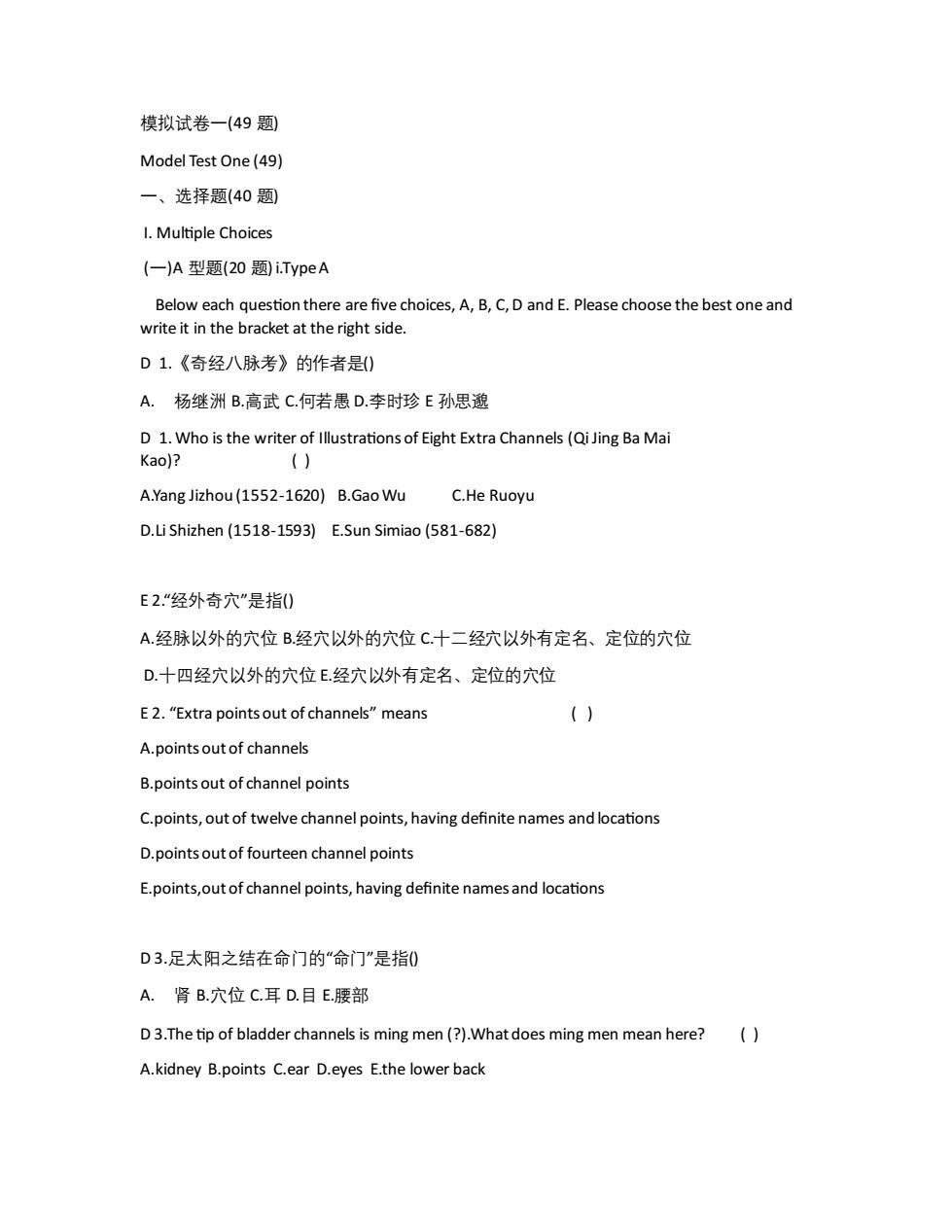
模拟试卷一(49题) Model Test One(49) 一、选择题(40题) 1.Multiple Choices (一)A型题(20题)i.Type A Below each question there are five choices,A,B,C,D and E.Please choose the best one and write it in the bracket at the right side. D1.《奇经八脉考》的作者是() A.杨继洲B.高武C何若愚D.李时珍E孙思邈 D 1.Who is the writer of Illustrations of Eight Extra Channels(Qi Jing Ba Mai Kao)? () A.Yang Jizhou(1552-1620)B.Gao Wu C.He Ruoyu D.Li Shizhen(1518-1593)E.Sun Simiao(581-682) E2“经外奇穴"是指(0 A.经脉以外的穴位B经穴以外的穴位C.十二经穴以外有定名、定位的穴位 D.十四经穴以外的穴位E经穴以外有定名、定位的穴位 E2."Extra points out of channels"means () A.points out of channels B.points out of channel points C.points,out of twelve channel points,having definite names and locations D.points out of fourteen channel points E.points,out of channel points,having definite names and locations D3.足太阳之结在命门的"命门”是指0 A.肾B.穴位C.耳D.目E腰部 D3.The tip of bladder channels is ming men(?).What does ming men mean here? A.kidney B.points C.ear D.eyes E.the lower back
模拟试卷一(49 题) Model Test One (49) 一、选择题(40 题) I. Multiple Choices (一)A 型题(20 题) i.Type A Below each question there are five choices, A, B, C, D and E. Please choose the best one and write it in the bracket at the right side. D 1.《奇经八脉考》的作者是() A. 杨继洲 B.高武 C.何若愚 D.李时珍 E 孙思邈 D 1. Who is the writer of Illustrations of Eight Extra Channels (Qi Jing Ba Mai Kao)? ( ) A.Yang Jizhou (1552-1620) B.Gao Wu C.He Ruoyu D.Li Shizhen (1518-1593) E.Sun Simiao (581-682) E 2.“经外奇穴”是指() A.经脉以外的穴位 B.经穴以外的穴位 C.十二经穴以外有定名、定位的穴位 D.十四经穴以外的穴位 E.经穴以外有定名、定位的穴位 E 2. “Extra points out of channels” means ( ) A.points out of channels B.points out of channel points C.points, out of twelve channel points, having definite names and locations D.points out of fourteen channel points E.points,out of channel points, having definite names and locations D 3.足太阳之结在命门的“命门”是指() A. 肾 B.穴位 C.耳 D.目 E.腰部 D 3.The tip of bladder channels is ming men (?).What does ming men mean here? ( ) A.kidney B.points C.ear D.eyes E.the lower back
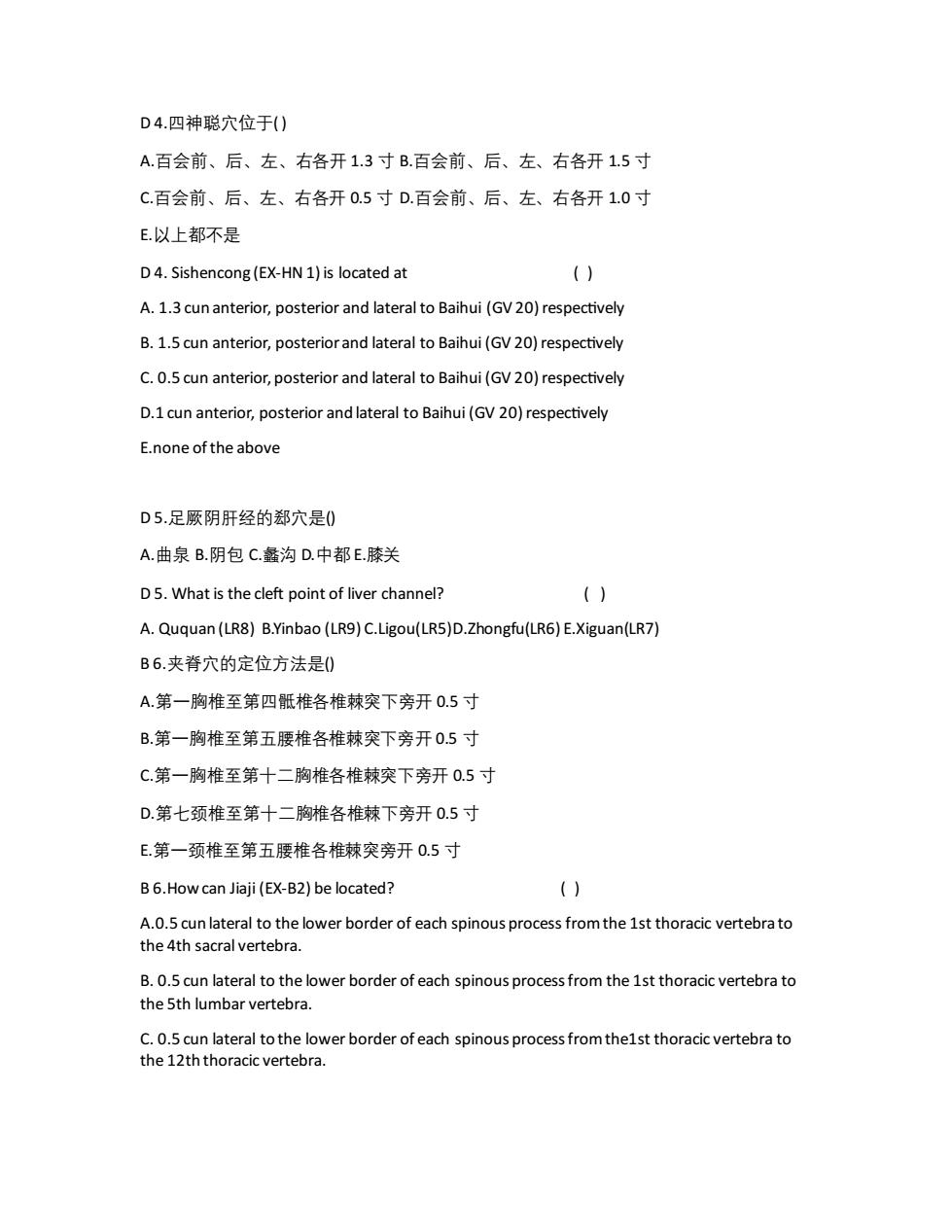
D4.四神聪穴位于() A.百会前、后、左、右各开1.3寸B.百会前、后、左、右各开1.5寸 C.百会前、后、左、右各开0.5寸D.百会前、后、左、右各开1.0寸 E.以上都不是 D4.Sishencong(EX-HN 1)is located at () A.1.3 cun anterior,posterior and lateral to Baihui(GV 20)respectively B.1.5 cun anterior,posterior and lateral to Baihui(GV 20)respectively C.0.5 cun anterior,posterior and lateral to Baihui(GV 20)respectively D.1 cun anterior,posterior and lateral to Baihui(GV 20)respectively E.none of the above D5.足厥阴肝经的郄穴是0 A.曲泉B.阴包C.蠡沟D.中都E.膝关 D5.What is the cleft point of liver channel? () A.Ququan (LR8)B.Yinbao(LR9)C.Ligou(LR5)D.Zhongfu(LR6)E.Xiguan(LR7) B6.夹脊穴的定位方法是(0 A.第一胸椎至第四骶椎各椎棘突下旁开0.5寸 B.第一胸椎至第五腰椎各椎棘突下旁开0.5寸 C.第一胸椎至第十二胸椎各椎棘突下旁开0.5寸 D.第七颈椎至第十二胸椎各椎棘下旁开0.5寸 E.第一颈椎至第五腰椎各椎棘突旁开0.5寸 B6.How can Jiaji(EX-B2)be located? () A.0.5 cun lateral to the lower border of each spinous process from the 1st thoracic vertebra to the 4th sacral vertebra. B.0.5 cun lateral to the lower border of each spinous process from the 1st thoracic vertebra to the 5th lumbar vertebra. C.0.5 cun lateral to the lower border of each spinous process from thelst thoracic vertebra to the 12th thoracic vertebra
D 4.四神聪穴位于( ) A.百会前、后、左、右各开 1.3 寸 B.百会前、后、左、右各开 1.5 寸 C.百会前、后、左、右各开 0.5 寸 D.百会前、后、左、右各开 1.0 寸 E.以上都不是 D 4. Sishencong (EX-HN 1) is located at ( ) A. 1.3 cun anterior, posterior and lateral to Baihui (GV 20) respectively B. 1.5 cun anterior, posterior and lateral to Baihui (GV 20) respectively C. 0.5 cun anterior, posterior and lateral to Baihui (GV 20) respectively D.1 cun anterior, posterior and lateral to Baihui (GV 20) respectively E.none of the above D 5.足厥阴肝经的郄穴是() A.曲泉 B.阴包 C.蠡沟 D.中都 E.膝关 D 5. What is the cleft point of liver channel? ( ) A. Ququan (LR8) B.Yinbao (LR9) C.Ligou(LR5)D.Zhongfu(LR6) E.Xiguan(LR7) B 6.夹脊穴的定位方法是() A.第一胸椎至第四骶椎各椎棘突下旁开 0.5 寸 B.第一胸椎至第五腰椎各椎棘突下旁开 0.5 寸 C.第一胸椎至第十二胸椎各椎棘突下旁开 0.5 寸 D.第七颈椎至第十二胸椎各椎棘下旁开 0.5 寸 E.第一颈椎至第五腰椎各椎棘突旁开 0.5 寸 B 6.How can Jiaji (EX-B2) be located? ( ) A.0.5 cun lateral to the lower border of each spinous process from the 1st thoracic vertebra to the 4th sacral vertebra. B. 0.5 cun lateral to the lower border of each spinous process from the 1st thoracic vertebra to the 5th lumbar vertebra. C. 0.5 cun lateral to the lower border of each spinous process from the1st thoracic vertebra to the 12th thoracic vertebra
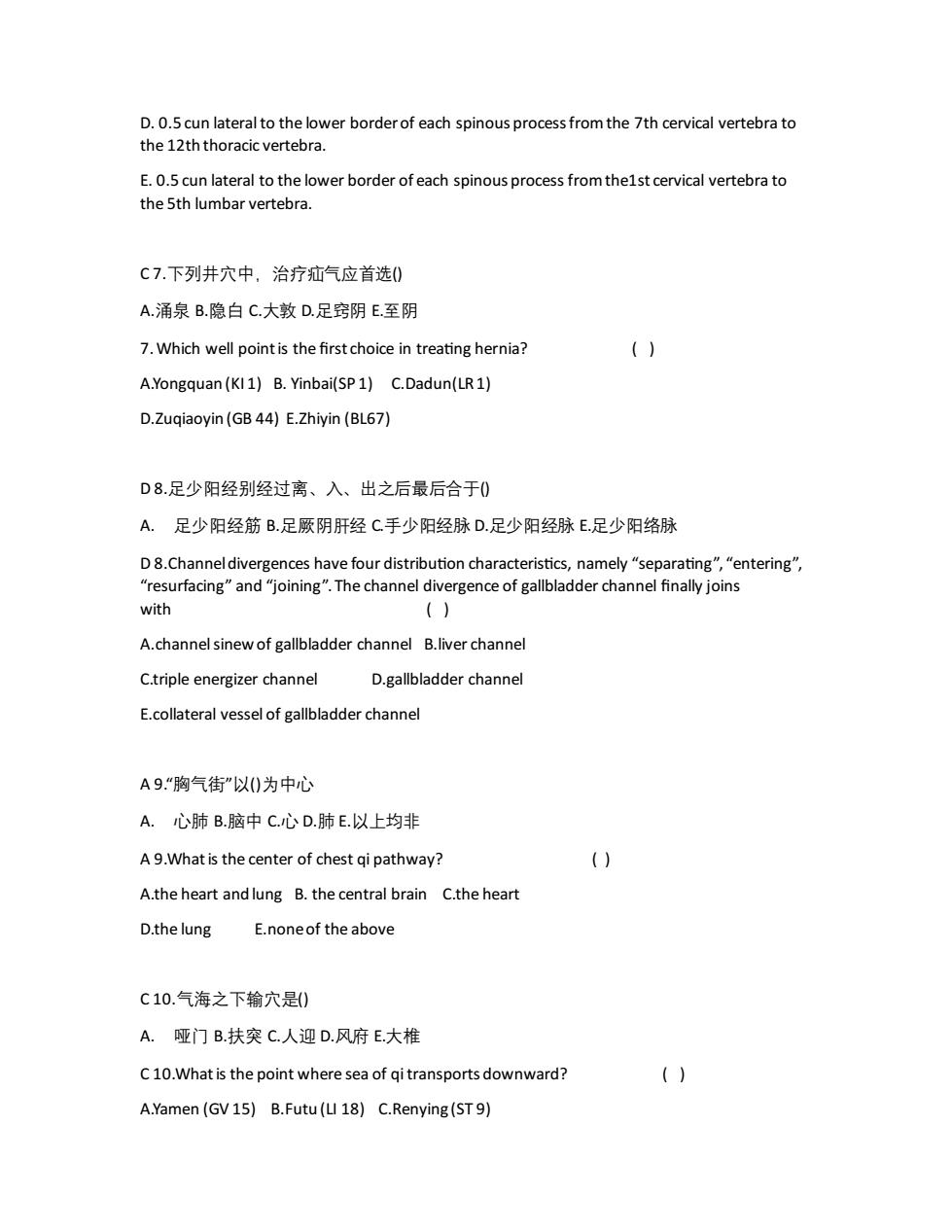
D.0.5 cun lateral to the lower border of each spinous process from the 7th cervical vertebra to the 12th thoracic vertebra. E.0.5 cun lateral to the lower border of each spinous process from thelst cervical vertebra to the 5th lumbar vertebra. C7.下列井穴中,治疗疝气应首选0 A.涌泉B.隐白C.大敦D.足窍阴E.至阴 7.Which well point is the first choice in treating hernia? () A.Yongquan(KI1)B.Yinbai(SP 1)C.Dadun(LR 1) D.Zuqiaoyin(GB 44)E.Zhiyin(BL67) D8.足少阳经别经过离、入、出之后最后合于0 A.足少阳经筋B.足厥阴肝经C.手少阳经脉D.足少阳经脉E足少阳络脉 D8.Channel divergences have four distribution characteristics,namely "separating","entering", "resurfacing"and "joining".The channel divergence of gallbladder channel finally joins with () A.channel sinew of gallbladder channel B.liver channel C.triple energizer channel D.gallbladder channel E.collateral vessel of gallbladder channel A9.“胸气街”以(0为中心 A.心肺B.脑中C.心D.肺E.以上均非 A9.What is the center of chest qi pathway? () A.the heart and lung B.the central brain C.the heart D.the lung E.none of the above C10.气海之下输穴是0) A.哑门B.扶突C.人迎D.风府E.大椎 C 10.What is the point where sea of qitransports downward? ( A.Yamen(GV 15)B.Futu(LI 18)C.Renying(ST 9)
D. 0.5 cun lateral to the lower border of each spinous process from the 7th cervical vertebra to the 12th thoracic vertebra. E. 0.5 cun lateral to the lower border of each spinous process from the1st cervical vertebra to the 5th lumbar vertebra. C 7.下列井穴中,治疗疝气应首选() A.涌泉 B.隐白 C.大敦 D.足窍阴 E.至阴 7. Which well point is the first choice in treating hernia? ( ) A.Yongquan (KI 1) B. Yinbai(SP 1) C.Dadun(LR 1) D.Zuqiaoyin (GB 44) E.Zhiyin (BL67) D 8.足少阳经别经过离、入、出之后最后合于() A. 足少阳经筋 B.足厥阴肝经 C.手少阳经脉 D.足少阳经脉 E.足少阳络脉 D 8.Channel divergences have four distribution characteristics, namely “separating”, “entering”, “resurfacing” and “joining”. The channel divergence of gallbladder channel finally joins with ( ) A.channel sinew of gallbladder channel B.liver channel C.triple energizer channel D.gallbladder channel E.collateral vessel of gallbladder channel A 9.“胸气街”以()为中心 A. 心肺 B.脑中 C.心 D.肺 E.以上均非 A 9.What is the center of chest qi pathway? ( ) A.the heart and lung B. the central brain C.the heart D.the lung E.none of the above C 10.气海之下输穴是() A. 哑门 B.扶突 C.人迎 D.风府 E.大椎 C 10.What is the point where sea of qi transports downward? ( ) A.Yamen (GV 15) B.Futu (LI 18) C.Renying (ST 9)
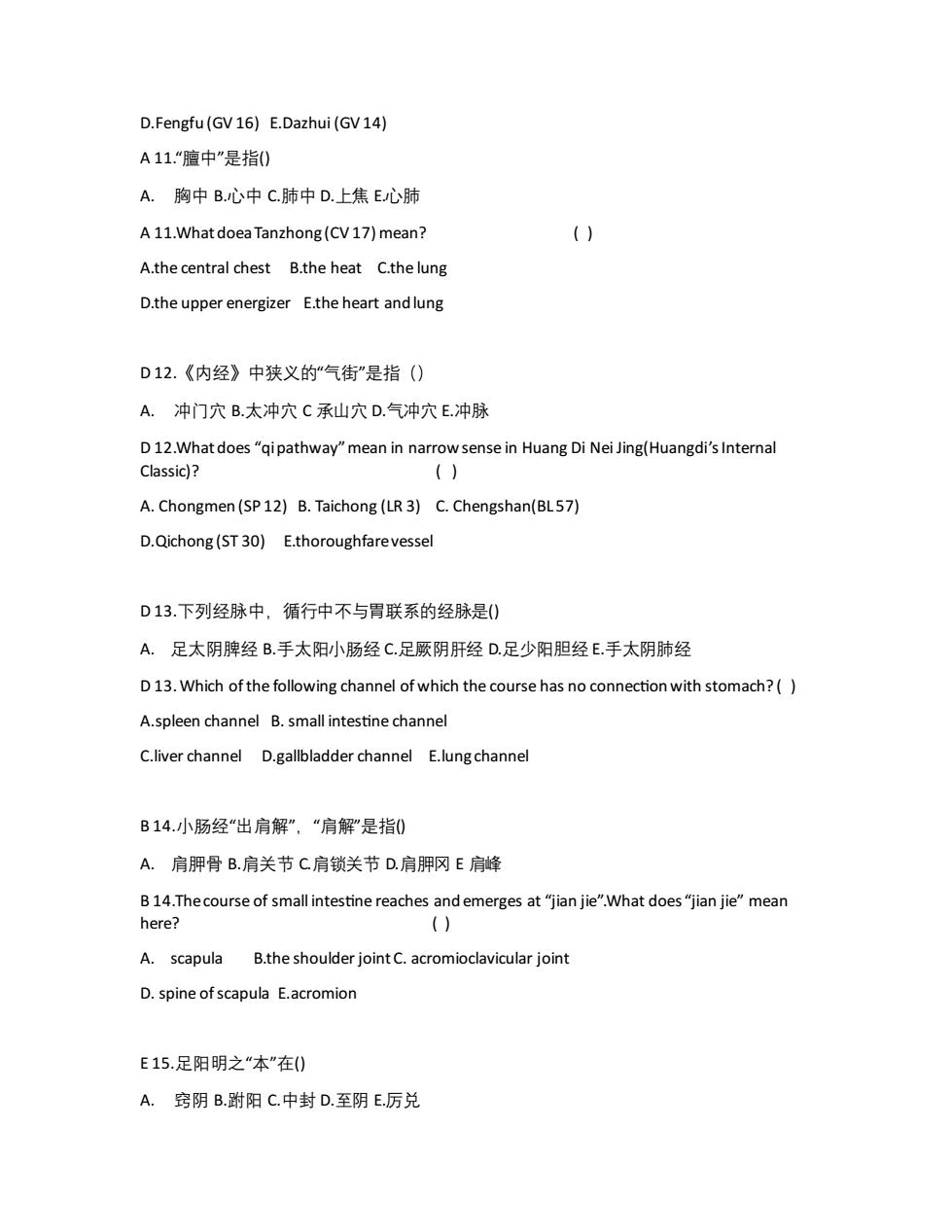
D.Fengfu(GV 16)E.Dazhui(GV 14) A11.“膻中”是指0 A.胸中B.心中C肺中D.上焦E心肺 A 11.What doea Tanzhong(CV 17)mean? A.the central chest B.the heat C.the lung D.the upper energizer E.the heart and lung D12.《内经》中狭义的“气街”是指() A.冲门穴B.太冲穴C承山穴D.气冲穴E.冲脉 D 12.What does"qipathway"mean in narrow sense in Huang Di Nei Jing(Huangdi's Internal Classic)? () A.Chongmen(SP 12)B.Taichong(LR 3)C.Chengshan(BL57) D.Qichong(ST 30)E.thoroughfare vessel D13.下列经脉中,循行中不与胃联系的经脉是(0 A.足太阴脾经B.手太阳小肠经C.足厥阴肝经D.足少阳胆经E.手太阴肺经 D 13.Which of the following channel of which the course has no connection with stomach?() A.spleen channel B.small intestine channel C.liver channel D.gallbladder channel E.lung channel B14.小肠经“出肩解”,“肩解是指0 A.肩胛骨B.肩关节C.肩锁关节D.肩胛冈E肩峰 B 14.The course of small intestine reaches and emerges at "jian jie".What does"jian jie"mean here? () A.scapula B.the shoulder joint C.acromioclavicular joint D.spine of scapula E.acromion E15.足阳明之“本"在(0 A.窍阴B.跗阳C.中封D.至阴E.厉兑
D.Fengfu (GV 16) E.Dazhui (GV 14) A 11.“膻中”是指() A. 胸中 B.心中 C.肺中 D.上焦 E.心肺 A 11.What doea Tanzhong (CV 17) mean? ( ) A.the central chest B.the heat C.the lung D.the upper energizer E.the heart and lung D 12.《内经》中狭义的“气街”是指() A. 冲门穴 B.太冲穴 C 承山穴 D.气冲穴 E.冲脉 D 12.What does “qi pathway” mean in narrow sense in Huang Di Nei Jing(Huangdi’s Internal Classic)? ( ) A. Chongmen (SP 12) B. Taichong (LR 3) C. Chengshan(BL 57) D.Qichong (ST 30) E.thoroughfare vessel D 13.下列经脉中,循行中不与胃联系的经脉是() A. 足太阴脾经 B.手太阳小肠经 C.足厥阴肝经 D.足少阳胆经 E.手太阴肺经 D 13. Which of the following channel of which the course has no connection with stomach? ( ) A.spleen channel B. small intestine channel C.liver channel D.gallbladder channel E.lung channel B 14.小肠经“出肩解”,“肩解”是指() A. 肩胛骨 B.肩关节 C.肩锁关节 D.肩胛冈 E 肩峰 B 14.The course of small intestine reaches and emerges at “jian jie”.What does “jian jie” mean here? ( ) A. scapula B.the shoulder joint C. acromioclavicular joint D. spine of scapula E.acromion E 15.足阳明之“本”在() A. 窍阴 B.跗阳 C.中封 D.至阴 E.厉兑
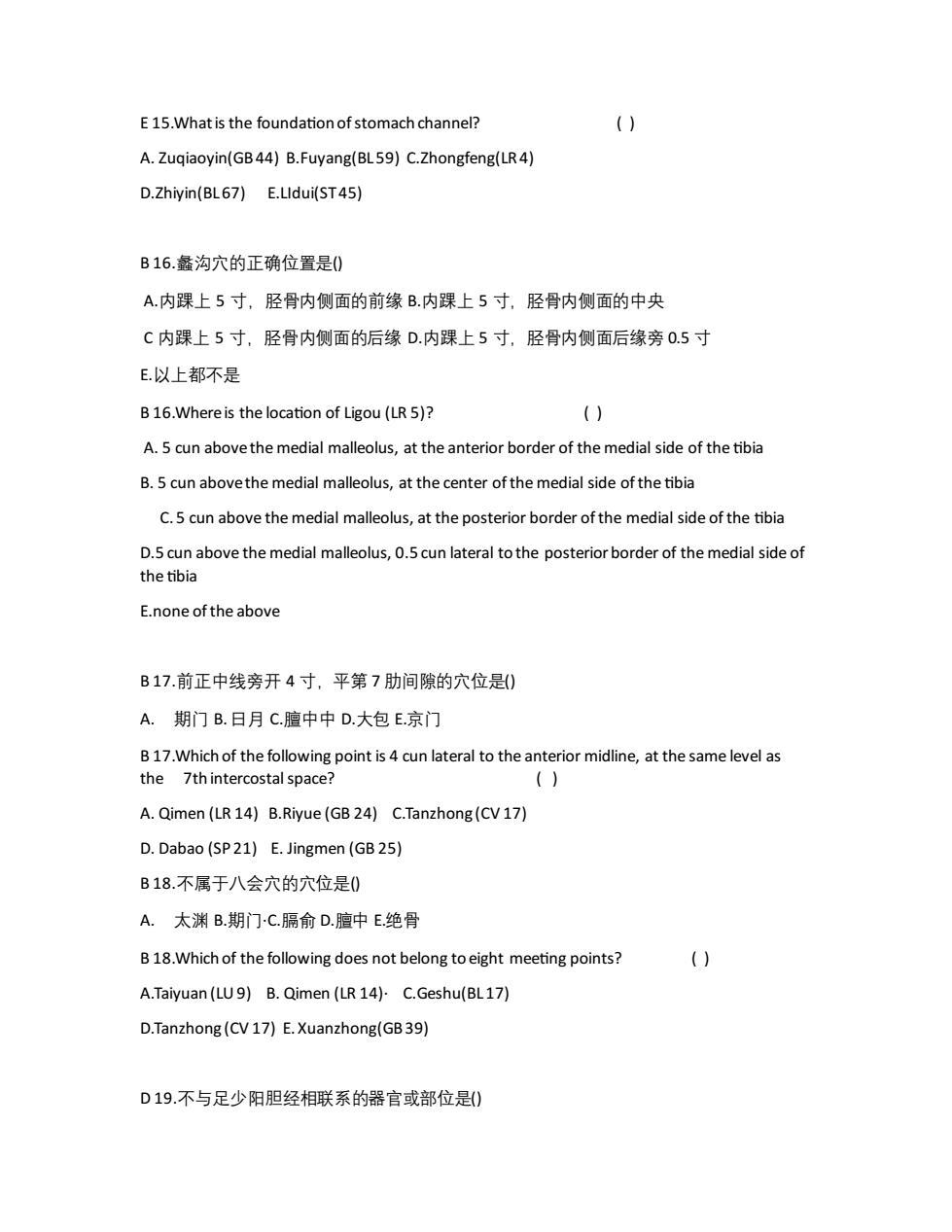
E 15.What is the foundation of stomach channel? A.Zuqiaoyin(GB44)B.Fuyang(BL59)C.Zhongfeng(LR 4) D.Zhiyin(BL67)E.Lldui(ST45) B16.蠡沟穴的正确位置是0 A.内踝上5寸,胫骨内侧面的前缘B.内踝上5寸,胫骨内侧面的中央 C内踝上5寸,胫骨内侧面的后缘D.内踝上5寸,胫骨内侧面后缘旁0.5寸 E.以上都不是 B 16.Where is the location of Ligou(LR 5)? () A.5 cun above the medial malleolus,at the anterior border of the medial side of the tibia B.5 cun abovethe medial malleolus,at the center of the medial side of the tibia C.5 cun above the medial malleolus,at the posterior border of the medial side of the tibia D.5 cun above the medial malleolus,0.5 cun lateral to the posterior border of the medial side of the tibia E.none of the above B17.前正中线旁开4寸,平第7肋间隙的穴位是0 A.期门B.日月C.膻中中D.大包E京门 B 17.Which of the following point is 4 cun lateral to the anterior midline,at the same level as the 7th intercostal space? () A.Qimen (LR 14)B.Riyue(GB 24)C.Tanzhong(CV 17) D.Dabao(SP21)E.Jingmen (GB 25) B18.不属于八会穴的穴位是0 A.太渊B.期门C膈俞D.膻中E绝骨 B 18.Which of the following does not belong to eight meeting points? () A.Taiyuan(LU 9)B.Qimen (LR 14).C.Geshu(BL17) D.Tanzhong(CV 17)E.Xuanzhong(GB39) D19.不与足少阳胆经相联系的器官或部位是()
E 15.What is the foundation of stomach channel? ( ) A. Zuqiaoyin(GB 44) B.Fuyang(BL 59) C.Zhongfeng(LR 4) D.Zhiyin(BL 67) E.LIdui(ST 45) B 16.蠡沟穴的正确位置是() A.内踝上 5 寸,胫骨内侧面的前缘 B.内踝上 5 寸,胫骨内侧面的中央 C 内踝上 5 寸,胫骨内侧面的后缘 D.内踝上 5 寸,胫骨内侧面后缘旁 0.5 寸 E.以上都不是 B 16.Where is the location of Ligou (LR 5)? ( ) A. 5 cun above the medial malleolus, at the anterior border of the medial side of the tibia B. 5 cun above the medial malleolus, at the center of the medial side of the tibia C. 5 cun above the medial malleolus, at the posterior border of the medial side of the tibia D.5 cun above the medial malleolus, 0.5 cun lateral to the posterior border of the medial side of the tibia E.none of the above B 17.前正中线旁开 4 寸,平第 7 肋间隙的穴位是() A. 期门 B.日月 C.膻中中 D.大包 E.京门 B 17.Which of the following point is 4 cun lateral to the anterior midline, at the same level as the 7th intercostal space? ( ) A. Qimen (LR 14) B.Riyue (GB 24) C.Tanzhong (CV 17) D. Dabao (SP 21) E. Jingmen (GB 25) B 18.不属于八会穴的穴位是() A. 太渊 B.期门·C.膈俞 D.膻中 E.绝骨 B 18.Which of the following does not belong to eight meeting points? ( ) A.Taiyuan (LU 9) B. Qimen (LR 14)· C.Geshu(BL 17) D.Tanzhong (CV 17) E. Xuanzhong(GB 39) D 19.不与足少阳胆经相联系的器官或部位是()
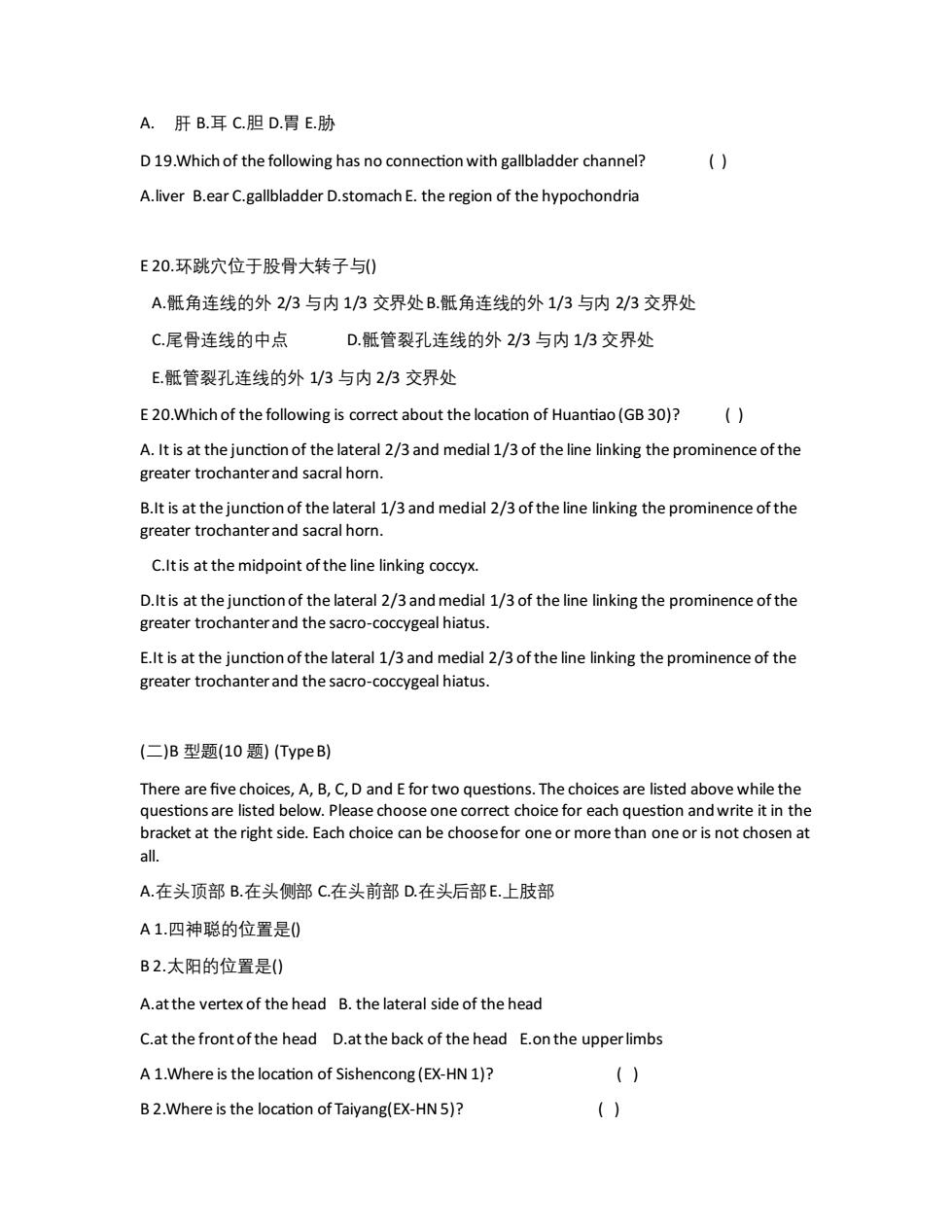
A.肝B.耳C.胆D.胃E胁 D 19.Which of the following has no connection with gallbladder channel? () A.liver B.ear C.gallbladder D.stomach E.the region of the hypochondria E20.环跳穴位于股骨大转子与) A.骶角连线的外2/3与内1/3交界处B.骶角连线的外1/3与内2/3交界处 C尾骨连线的中点 D.骶管裂孔连线的外2/3与内1/3交界处 E.骶管裂孔连线的外1/3与内23交界处 E 20.Which of the following is correct about the location of Huantiao(GB 30)? () A.It is at the junction of the lateral 2/3 and medial 1/3 of the line linking the prominence of the greater trochanter and sacral horn. B.It is at the junction of the lateral 1/3 and medial 2/3 of the line linking the prominence of the greater trochanter and sacral horn. C.It is at the midpoint of the line linking coccyx. D.It is at the junction of the lateral 2/3 and medial 1/3 of the line linking the prominence of the greater trochanter and the sacro-coccygeal hiatus. E.It is at the junction of the lateral 1/3 and medial 2/3 of the line linking the prominence of the greater trochanter and the sacro-coccygeal hiatus. (二)B型题(10题)(Type B) There are five choices,A,B,C,D and E for two questions.The choices are listed above while the questions are listed below.Please choose one correct choice for each question and write it in the bracket at the right side.Each choice can be choosefor one or more than one or is not chosen at all. A.在头顶部B.在头侧部C.在头前部D.在头后部E.上肢部 A1.四神聪的位置是0 B2.太阳的位置是(0 A.atthe vertex of the head B.the lateral side of the head C.at the front of the head D.at the back of the head E.on the upper limbs A 1.Where is the location of Sishencong(EX-HN 1)? () B 2.Where is the location of Taiyang(EX-HN 5)? ()
A. 肝 B.耳 C.胆 D.胃 E.胁 D 19.Which of the following has no connection with gallbladder channel? ( ) A.liver B.ear C.gallbladder D.stomach E. the region of the hypochondria E 20.环跳穴位于股骨大转子与() A.骶角连线的外 2/3 与内 1/3 交界处B.骶角连线的外 1/3 与内 2/3 交界处 C.尾骨连线的中点 D.骶管裂孔连线的外 2/3 与内 1/3 交界处 E.骶管裂孔连线的外 1/3 与内 2/3 交界处 E 20.Which of the following is correct about the location of Huantiao (GB 30)? ( ) A. It is at the junction of the lateral 2/3 and medial 1/3 of the line linking the prominence of the greater trochanter and sacral horn. B.It is at the junction of the lateral 1/3 and medial 2/3 of the line linking the prominence of the greater trochanter and sacral horn. C.It is at the midpoint of the line linking coccyx. D.It is at the junction of the lateral 2/3 and medial 1/3 of the line linking the prominence of the greater trochanter and the sacro-coccygeal hiatus. E.It is at the junction of the lateral 1/3 and medial 2/3 of the line linking the prominence of the greater trochanter and the sacro-coccygeal hiatus. (二)B 型题(10 题) (Type B) There are five choices, A, B, C, D and E for two questions. The choices are listed above while the questions are listed below. Please choose one correct choice for each question and write it in the bracket at the right side. Each choice can be choose for one or more than one or is not chosen at all. A.在头顶部 B.在头侧部 C.在头前部 D.在头后部E.上肢部 A 1.四神聪的位置是() B 2.太阳的位置是() A.at the vertex of the head B. the lateral side of the head C.at the front of the head D.at the back of the head E.on the upper limbs A 1.Where is the location of Sishencong (EX-HN 1)? ( ) B 2.Where is the location of Taiyang(EX-HN 5)? ( )
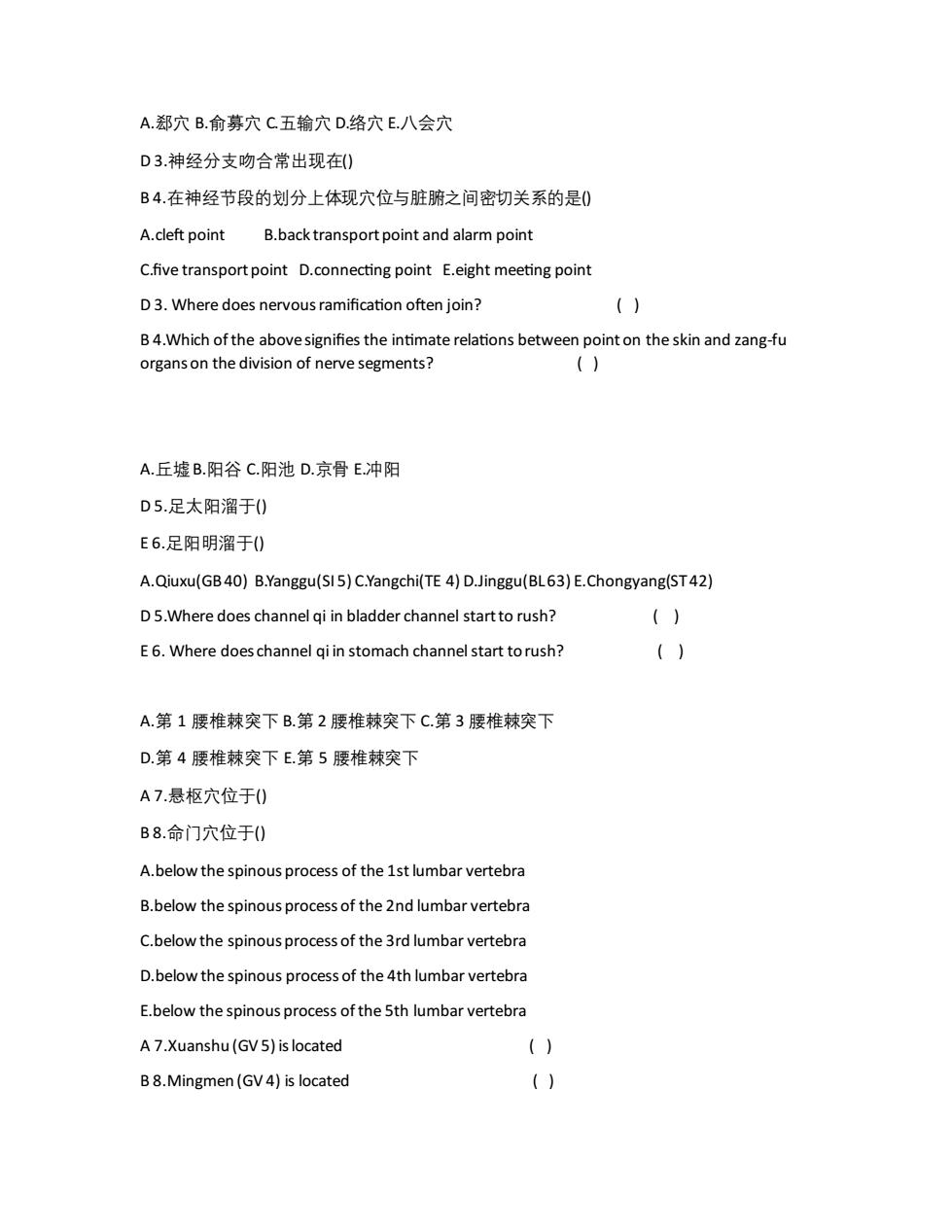
A.郄穴B.俞募穴C五输穴D.络穴E.八会穴 D3.神经分支吻合常出现在) B4.在神经节段的划分上体现穴位与脏腑之间密切关系的是0 A.cleft point B.back transport point and alarm point C.five transport point D.connecting point E.eight meeting point D 3.Where does nervous ramification often join? () B4.Which of the above signifies the intimate relations between point on the skin and zang-fu organs on the division of nerve segments? () A.丘墟B.阳谷C.阳池D.京骨E.冲阳 D5.足太阳溜于(0 E6.足阳明溜于0 A.Qiuxu(GB 40)B.Yanggu(SI5)C.Yangchi(TE 4)D.Jinggu(BL63)E.Chongyang(ST42) D 5.Where does channel qi in bladder channel startto rush? () E 6.Where does channel qi in stomach channel start to rush? () A.第1腰椎棘突下B.第2腰椎棘突下C.第3腰椎棘突下 D.第4腰椎棘突下E.第5腰椎棘突下 A7.悬枢穴位于(0 B8.命门穴位于(0 A.below the spinous process of the 1st lumbar vertebra B.below the spinous process of the 2nd lumbar vertebra C.below the spinous process of the 3rd lumbar vertebra D.below the spinous process of the 4th lumbar vertebra E.below the spinous process of the 5th lumbar vertebra A 7.Xuanshu(GV 5)is located () B8.Mingmen(GV 4)is located ()
A.郄穴 B.俞募穴 C.五输穴 D.络穴 E.八会穴 D 3.神经分支吻合常出现在() B 4.在神经节段的划分上体现穴位与脏腑之间密切关系的是() A.cleft point B.back transport point and alarm point C.five transport point D.connecting point E.eight meeting point D 3. Where does nervous ramification often join? ( ) B 4.Which of the above signifies the intimate relations between point on the skin and zang-fu organs on the division of nerve segments? ( ) A.丘墟B.阳谷 C.阳池 D.京骨 E.冲阳 D 5.足太阳溜于() E 6.足阳明溜于() A.Qiuxu(GB 40) B.Yanggu(SI 5) C.Yangchi(TE 4) D.Jinggu(BL 63) E.Chongyang(ST 42) D 5.Where does channel qi in bladder channel start to rush? ( ) E 6. Where does channel qi in stomach channel start to rush? ( ) A.第 1 腰椎棘突下 B.第 2 腰椎棘突下 C.第 3 腰椎棘突下 D.第 4 腰椎棘突下 E.第 5 腰椎棘突下 A 7.悬枢穴位于() B 8.命门穴位于() A.below the spinous process of the 1stlumbar vertebra B.below the spinous process of the 2nd lumbar vertebra C.below the spinous process of the 3rd lumbar vertebra D.below the spinous process of the 4th lumbar vertebra E.below the spinous process of the 5th lumbar vertebra A 7.Xuanshu (GV 5) is located ( ) B 8.Mingmen (GV 4) is located ( )
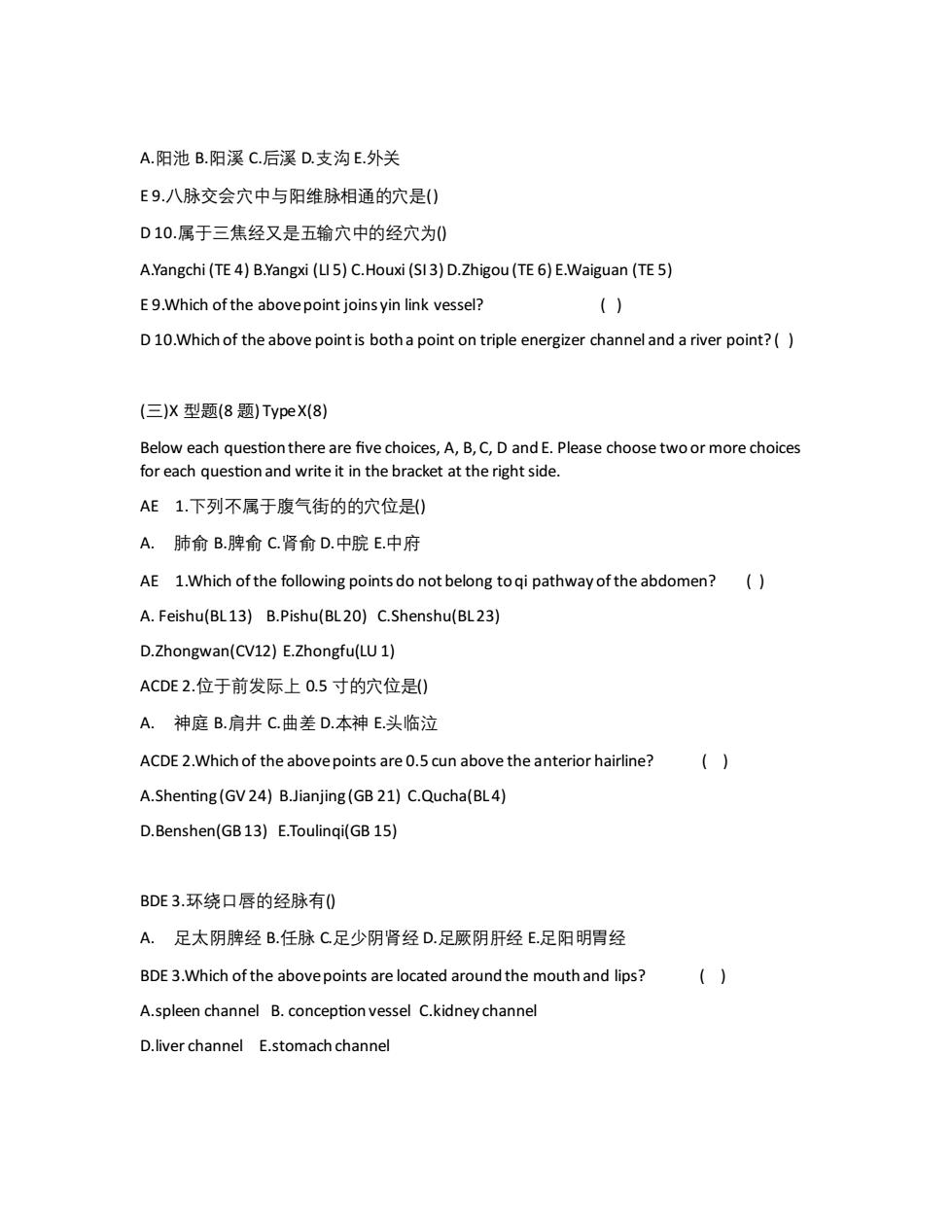
A.阳池B.阳溪C.后溪D.支沟E.外关 E9.八脉交会穴中与阳维脉相通的穴是() D10.属于三焦经又是五输穴中的经穴为0 A.Yangchi(TE 4)B.Yangxi(LI 5)C.Houxi(SI3)D.Zhigou (TE 6)E.Waiguan(TE 5) E9.Which of the above point joins yin link vessel? () D 10.Which of the above point is both a point on triple energizer channel and a river point?() (三)X型题(8题)Type X(8) Below each question there are five choices,A,B,C,D and E.Please choose two or more choices for each question and write it in the bracket at the right side. AE1.下列不属于腹气街的的穴位是) A.肺俞B.脾俞C.肾俞D.中脘E.中府 AE 1.Which of the following points do not belong to qi pathway of the abdomen?( A.Feishu(BL13)B.Pishu(BL20)C.Shenshu(BL23) D.Zhongwan(CV12)E.Zhongfu(LU 1) ACDE2.位于前发际上0.5寸的穴位是() A.神庭B.肩井C.曲差D.本神E头临泣 ACDE 2.Which of the above points are 0.5 cun above the anterior hairline? () A.Shenting(GV24)B.Jianjing(GB 21)C.Qucha(BL4) D.Benshen(GB13)E.Toulinqi(GB 15) BDE3.环绕口唇的经脉有0 A.足太阴脾经B任脉C足少阴肾经D.足厥阴肝经E足阳明胃经 BDE 3.Which of the above points are located around the mouth and lips? A.spleen channel B.conception vessel C.kidney channel D.liver channel E.stomach channel
A.阳池 B.阳溪 C.后溪 D.支沟 E.外关 E 9.八脉交会穴中与阳维脉相通的穴是( ) D 10.属于三焦经又是五输穴中的经穴为() A.Yangchi (TE 4) B.Yangxi (LI 5) C.Houxi (SI 3) D.Zhigou (TE 6) E.Waiguan (TE 5) E 9.Which of the above point joins yin link vessel? ( ) D 10.Which of the above point is both a point on triple energizer channel and a river point? ( ) (三)X 型题(8 题) Type X(8) Below each question there are five choices, A, B, C, D and E. Please choose two or more choices for each question and write it in the bracket at the right side. AE 1.下列不属于腹气街的的穴位是() A. 肺俞 B.脾俞 C.肾俞 D.中脘 E.中府 AE 1.Which of the following points do not belong to qi pathway of the abdomen? ( ) A. Feishu(BL 13) B.Pishu(BL 20) C.Shenshu(BL 23) D.Zhongwan(CV12) E.Zhongfu(LU 1) ACDE 2.位于前发际上 0.5 寸的穴位是() A. 神庭 B.肩井 C.曲差 D.本神 E.头临泣 ACDE 2.Which of the above points are 0.5 cun above the anterior hairline? ( ) A.Shenting (GV 24) B.Jianjing (GB 21) C.Qucha(BL 4) D.Benshen(GB 13) E.Toulinqi(GB 15) BDE 3.环绕口唇的经脉有() A. 足太阴脾经 B.任脉 C.足少阴肾经 D.足厥阴肝经 E.足阳明胃经 BDE 3.Which of the above points are located around the mouth and lips? ( ) A.spleen channel B. conception vessel C.kidney channel D.liver channel E.stomach channel
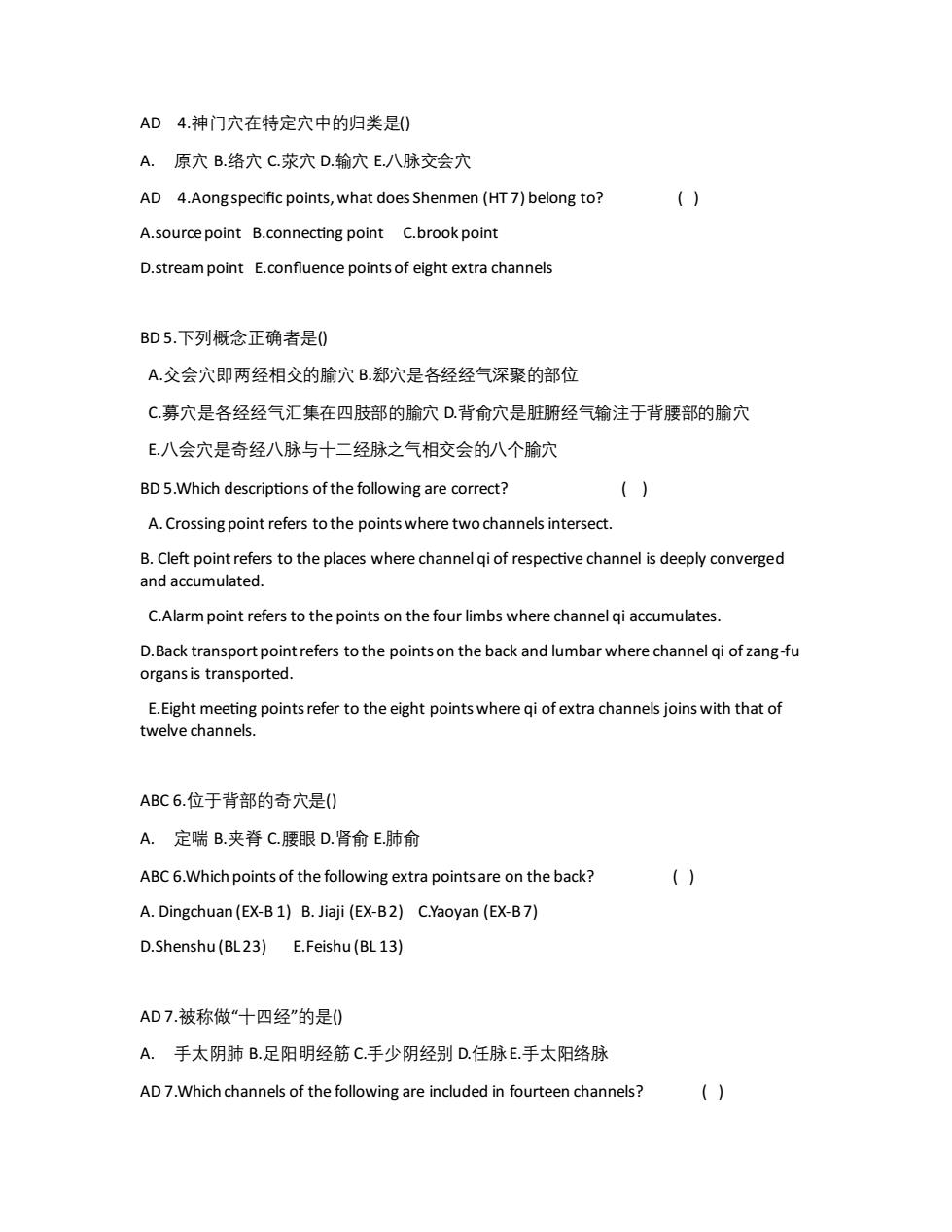
AD4.神门穴在特定穴中的归类是() A.原穴B.络穴C.荥穴D.输穴E.八脉交会穴 AD 4.Aong specific points,what does Shenmen(HT 7)belong to? A.source point B.connecting point C.brook point D.stream point E.confluence points of eight extra channels BD5.下列概念正确者是0 A.交会穴即两经相交的腧穴B.郄穴是各经经气深聚的部位 C募穴是各经经气汇集在四肢部的腧穴D.背俞穴是脏腑经气输注于背腰部的腧穴 E八会穴是奇经八脉与十二经脉之气相交会的八个腧穴 BD 5.Which descriptions of the following are correct? () A.Crossing point refers to the points where two channels intersect. B.Cleft point refers to the places where channel qi of respective channel is deeply converged and accumulated. C.Alarm point refers to the points on the four limbs where channel qi accumulates. D.Back transport point refers to the points on the back and lumbar where channel qi of zang-fu organs is transported. E.Eight meeting points refer to the eight points where qi of extra channels joins with that of twelve channels. ABC6.位于背部的奇穴是(0 A.定喘B.夹脊C腰眼D.肾俞E肺俞 ABC 6.Which points of the following extra points are on the back? () A.Dingchuan(EX-B 1)B.Jiaji (EX-B2)C.Yaoyan (EX-B7) D.Shenshu(BL23)E.Feishu(BL13) AD7.被称做“十四经"的是0 A.手太阴肺B.足阳明经筋c.手少阴经别D.任脉E.手太阳络脉 AD 7.Which channels of the following are included in fourteen channels? ()
AD 4.神门穴在特定穴中的归类是() A. 原穴 B.络穴 C.荥穴 D.输穴 E.八脉交会穴 AD 4.Aong specific points, what does Shenmen (HT 7) belong to? ( ) A.source point B.connecting point C.brook point D.stream point E.confluence points of eight extra channels BD 5.下列概念正确者是() A.交会穴即两经相交的腧穴 B.郄穴是各经经气深聚的部位 C.募穴是各经经气汇集在四肢部的腧穴 D.背俞穴是脏腑经气输注于背腰部的腧穴 E.八会穴是奇经八脉与十二经脉之气相交会的八个腧穴 BD 5.Which descriptions of the following are correct? ( ) A. Crossing point refers to the points where two channels intersect. B. Cleft point refers to the places where channel qi of respective channel is deeply converged and accumulated. C.Alarm point refers to the points on the four limbs where channel qi accumulates. D.Back transport point refers to the points on the back and lumbar where channel qi of zang-fu organs is transported. E.Eight meeting points refer to the eight points where qi of extra channels joins with that of twelve channels. ABC 6.位于背部的奇穴是() A. 定喘 B.夹脊 C.腰眼 D.肾俞 E.肺俞 ABC 6.Which points of the following extra points are on the back? ( ) A. Dingchuan (EX-B 1) B. Jiaji (EX-B 2) C.Yaoyan (EX-B 7) D.Shenshu (BL 23) E.Feishu (BL 13) AD 7.被称做“十四经”的是() A. 手太阴肺 B.足阳明经筋 C.手少阴经别 D.任脉E.手太阳络脉 AD 7.Which channels of the following are included in fourteen channels? ( )
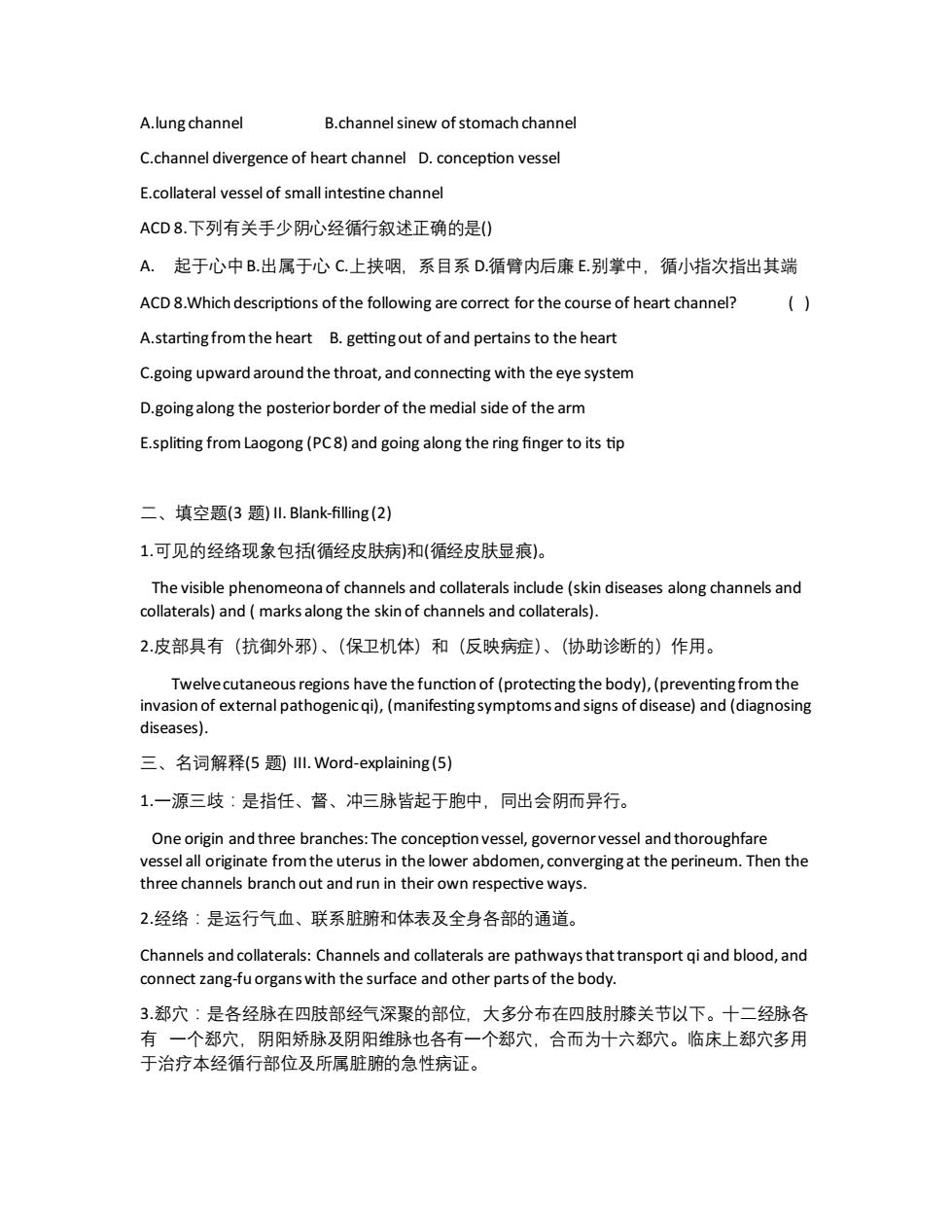
A.lung channel B.channel sinew of stomach channel C.channel divergence of heart channel D.conception vessel E.collateral vessel of small intestine channel ACD8.下列有关手少阴心经循行叙述正确的是() A.起于心中B出属于心C.上挟咽,系目系D.循臂内后廉E别掌中,循小指次指出其端 ACD 8.Which descriptions of the following are correct for the course of heart channel? () A.starting from the heart B.getting out of and pertains to the heart C.going upward around the throat,and connecting with the eye system D.going along the posterior border of the medial side of the arm E.spliting from Laogong(PC8)and going along the ring finger to its tip 二、填空题(3题)l.Blank-filling(2) 1.可见的经络现象包括循经皮肤病)和(循经皮肤显痕)。 The visible phenomeona of channels and collaterals include(skin diseases along channels and collaterals)and marks along the skin of channels and collaterals). 2皮部具有(抗御外邪)、(保卫机体)和(反映病症)、(协助诊断的)作用。 Twelve cutaneous regions have the function of(protecting the body),(preventing from the invasion of external pathogenicqi),(manifesting symptoms and signs of disease)and(diagnosing diseases). 三、名词解释(5题)ll.Word-explaining(5) 1.一源三歧:是指任、督、冲三脉皆起于胞中,同出会阴而异行。 One origin and three branches:The conception vessel,governor vessel and thoroughfare vessel all originate from the uterus in the lower abdomen,converging at the perineum.Then the three channels branch out and run in their own respective ways. 2经络:是运行气血、联系脏腑和体表及全身各部的通道。 Channels and collaterals:Channels and collaterals are pathways that transport qi and blood,and connect zang-fu organs with the surface and other parts of the body. 3郄穴:是各经脉在四肢部经气深聚的部位,大多分布在四肢肘膝关节以下。十二经脉各 有一个郄穴,阴阳矫脉及阴阳维脉也各有一个郄穴,合而为十六郄穴。临床上郄穴多用 于治疗本经循行部位及所属脏腑的急性病证
A.lung channel B.channel sinew of stomach channel C.channel divergence of heart channel D. conception vessel E.collateral vessel of small intestine channel ACD 8.下列有关手少阴心经循行叙述正确的是() A. 起于心中B.出属于心 C.上挟咽,系目系 D.循臂内后廉 E.别掌中,循小指次指出其端 ACD 8.Which descriptions of the following are correct for the course of heart channel? ( ) A.starting from the heart B. getting out of and pertains to the heart C.going upward around the throat, and connecting with the eye system D.going along the posterior border of the medial side of the arm E.spliting from Laogong (PC 8) and going along the ring finger to its tip 二、填空题(3 题) II. Blank-filling (2) 1.可见的经络现象包括(循经皮肤病)和(循经皮肤显痕)。 The visible phenomeona of channels and collaterals include (skin diseases along channels and collaterals) and ( marks along the skin of channels and collaterals). 2.皮部具有(抗御外邪)、(保卫机体)和(反映病症)、(协助诊断的)作用。 Twelve cutaneous regions have the function of (protecting the body), (preventing from the invasion of external pathogenic qi), (manifesting symptoms and signs of disease) and (diagnosing diseases). 三、名词解释(5 题) III. Word-explaining (5) 1.一源三歧:是指任、督、冲三脉皆起于胞中,同出会阴而异行。 One origin and three branches: The conception vessel, governor vessel and thoroughfare vessel all originate from the uterus in the lower abdomen, converging at the perineum. Then the three channels branch out and run in their own respective ways. 2.经络:是运行气血、联系脏腑和体表及全身各部的通道。 Channels and collaterals: Channels and collaterals are pathways that transport qi and blood, and connect zang-fu organs with the surface and other parts of the body. 3.郄穴:是各经脉在四肢部经气深聚的部位,大多分布在四肢肘膝关节以下。十二经脉各 有 一个郄穴,阴阳矫脉及阴阳维脉也各有一个郄穴,合而为十六郄穴。临床上郄穴多用 于治疗本经循行部位及所属脏腑的急性病证